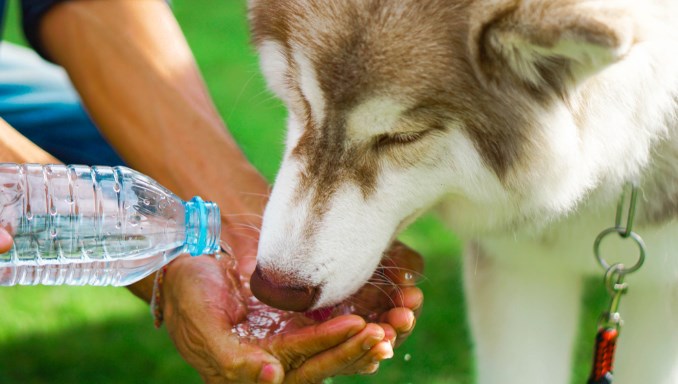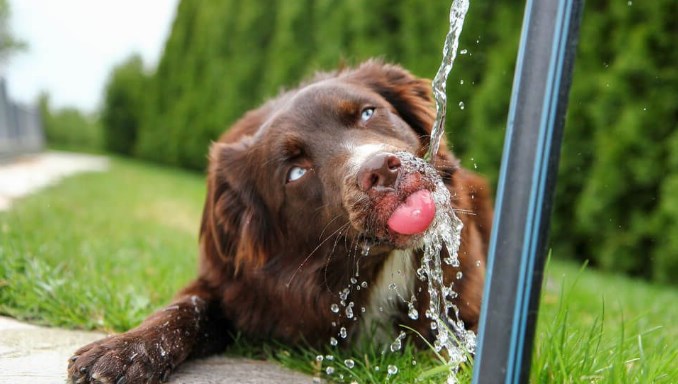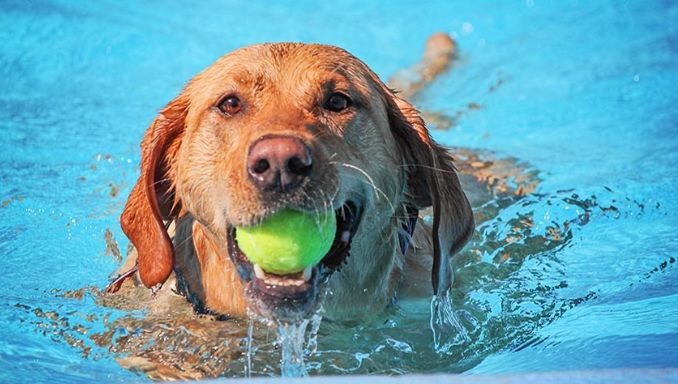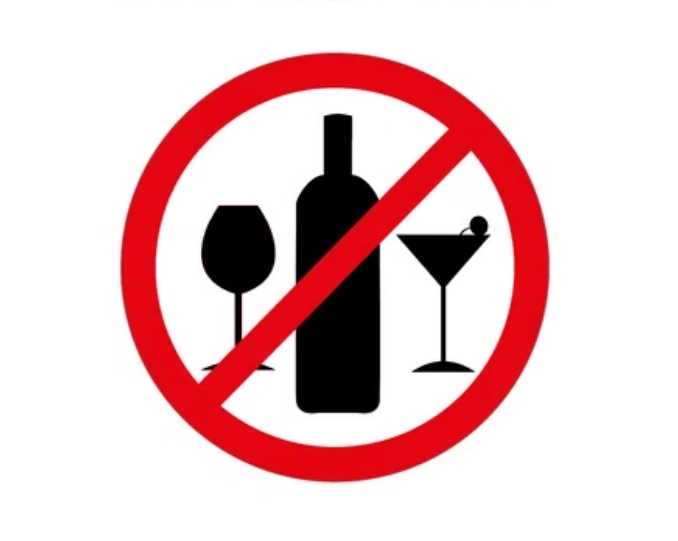How Long Can a Dog Go without Water?
Dogs are natural-born water lovers, but sometimes they go a little too long without a drink. How long can a dog go without water before it becomes dehydrated and potentially dangerous?
It is commonly said that dogs can go without water for up to a week. But how long can they really last without it? And what are the dangers of not providing your dog with enough H2O? In this blog post, we take a closer look at how much water dogs need on a daily basis and how you can tell if your pup is getting too little or too much. Stay hydrated, my friends!
Importance Of Water For Dogs
As a dog owner, you are probably aware of the importance of water for your pet. Water is essential for all dogs, and it is important to make sure that your dog always has access to clean, fresh water.
Water helps to keep your dog’s body temperature regulated, and it also aids in digestion and metabolism. Water is also necessary for the transportation of nutrients and oxygen throughout the body.
Water is essential for all mammals, including dogs. It helps to regulate body temperature, carries nutrients and oxygen to cells, flushes toxins from organs, and lubricates joints. In short, water is vital for a dog’s overall health and wellbeing.
How Long Can A Dog Go Without Water?
As we mentioned above, it is commonly said that dogs can go without water for up to a week. But this is not entirely accurate.
The truth is, dogs can only survive without water for a few days. After three to five days without water, most dogs will start to experience the effects of dehydration, which can be deadly.
Dehydration is a serious condition that can occur when the body does not have enough fluids to function properly. When a dog is dehydrated, their organs are not able to work properly, and they may even experience organ failure.
What Happens To Dogs Without Water?
Dogs can go without water for a lot longer than we can, but that doesn’t mean they don’t need it. In fact, even a small loss of body water can have a big impact on your dog’s health.
A dog that is dehydrated will have a dry nose and mouth, sunken eyes, and may be lethargic. Dehydration can lead to more serious problems, such as organ damage, heat stroke, and even death.

Reasons Why Dogs Get Dehydrated
Now you know How Long Can a Dog Go without Water, but do you know why dogs get dehydrated. There are many reasons why dogs might get dehydrated. Some of the most common include:
1) Vomiting or diarrhea can cause dehydration if your dog is losing more fluids than they are taking in.
2) If your dog is not drinking enough water, they will obviously become dehydrated. This can be due to many things including illness, not having access to clean water, or simply forgetting to drink.
3) Excessive panting can also lead to dehydration as your dog is losing water through their breath. This is often seen in dogs that are anxious or stressed, or those that are exercising heavily.
4) Fever can cause dehydration as your dog is losing water through their skin as they sweat.
5) Some medications can cause dehydration as a side effect. For example, diuretics help your dog to urinate more frequently which can lead to dehydration if they are not drinking enough water to replace the lost fluids.
6) Hot weather can also cause dehydration as your dog pant more and sweat more in an attempt to cool down.
If you think your dog might be dehydrated, it is important to take them to see a vet as soon as possible. Dehydration can cause serious health problems and even death if it is not treated quickly. Symptoms of dehydration in dogs include:
1) lethargy and tiredness
2) dry mouth
3) sunken eyes
4) decreased skin elasticity (skin that doesn’t snap back when pinched)
5) increased heart rate
6) rapid breathing
7) loss of appetite.
If you see any of these signs, take your dog to the vet immediately. They will likely give your dog fluids IV to rehydrate them quickly. In severe cases, hospitalization may be necessary.
Most people know that dogs need water to survive, but many don’t realize the importance of keeping their dog hydrated. Dehydration can lead to serious health problems in dogs, so it’s important to be aware of the signs and how to prevent it.
One of the first signs of dehydration is increased thirst. If your dog is drinking more water than usual, or seems to be always thirsty, it’s a good sign that they are already dehydrated. Other signs include decreased energy levels, dry nose and gums, sunken eyes, and increased panting.
What To Do If Your Dog Is Dehydrated
If your dog is dehydrated, it is important to act quickly. Dehydration can lead to serious medical problems and even death. Symptoms of dehydration include sunken eyes, lethargy, dry mouth, and increased thirst. If you suspect that your dog is dehydrated, take them to the vet immediately. treatment will vary depending on the severity of the dehydration, but may include fluids given intravenously or subcutaneously. In mild cases, your dog may simply need to be given fluids orally.
If you are out and about with your dog and they start to show signs of dehydration, stop and give them water right away. If they are not able to drink on their own, you can give them small amounts of water with a syringe or eyedropper. Once you get home, call your vet and tell them what happened. They may want you to bring your dog in for an examination.
Dehydration is serious and can be life-threatening, so it is important to act quickly if you think your dog is dehydrated. If you are unsure whether or not your dog is dehydrated, err on the side of caution and take them to the vet right away. In the meantime, you can try to rehydrate your dog by offering them water or ice cubes to lick, or giving them small sips of water from a syringe or dropper.
How Much Water Does A Dog Need?
The amount of water a dog needs depends on a few factors, such as their size, activity level, and whether they are pregnant or nursing.
On average, an adult dog needs about one ounce of water per pound of body weight each day. For example, a 20-pound dog would need about 20 ounces of water per day.
Puppies and senior dogs may need more or less water than this, so it’s best to consult with your vet. They can help you determine how much water your dog needs based on their individual needs.

How To Keep Your Dog Hydrated
One of the most important things you can do for your dog is to make sure they stay hydrated. Dogs need water to keep their bodies functioning properly, and just like humans, they can become dehydrated if they don’t drink enough. Dehydration can lead to serious health problems, so it’s important to be aware of the signs and know how to keep your dog hydrated.
The first step is to make sure your dog has access to fresh, clean water at all times. If you’re out and about, bring along a portable water bowl and offer your dog water regularly. If you’re at home, make sure their water bowl is in a convenient location and fill it up daily.
Another way to keep your dog hydrated is to offer them wet food or add water to their dry food. This is especially important in hot weather, when they may not be as likely to drink water on their own. You can also give them occasional treats like frozen dog bones or Kongs filled with water or broth.
If you’re concerned that your dog is not drinking enough water, pay attention to their urination. If they’re urinating less frequently or their urine appears darker than usual, it’s a sign they may be dehydrated. Other signs include dry nose or gums, lethargy, and loss of appetite. If you notice any of these signs, offer your dog water and contact your veterinarian.
Some Tips For Keeping Your Dog Hydrated:
- Offer your dog fresh, clean water at all times.
- If you’re out and about, bring along a portable water bowl and offer your dog water regularly.
- If you’re at home, make sure their water bowl is in a convenient location and fill it up daily.
- Another way to keep your dog hydrated is to offer them wet food or add water to their dry food.
- Consider adding a water fountain.
- Check your dog’s water bowl regularly and refill it as needed.
- Encourage your dog to drink water by adding flavored enhancements.
- Visit the vet if you are concerned about your dog’s hydration levels.
- If you’re concerned that your dog is not drinking enough water, pay attention to their urination. If they’re urinating less frequently or their urine appears darker than usual, it’s a sign they may be dehydrated.
How to Reduce Dehydration For Dogs In The Summer
As the weather gets warmer, it’s important to be mindful of your dog’s hydration levels. Here are a few tips to help reduce dehydration in dogs during the summer months:
1. Increase your dog’s access to water. This means making sure they always have a clean, full bowl of water available, and bringing water with you when you go on walks or hikes.
2. Add some electrolytes to your dog’s water. This will help replenish any that are lost through sweating or panting.
3.Limit your dog’s time in the sun. If they must be outside, make sure they have a shady spot to rest in and take breaks often.
4. Never leave your dog in a parked car. Temperatures can rise quickly inside a car, leading to dehydration and heatstroke.
5. Know the signs of dehydration. These include excessive panting, lethargy, dry mouth, and sunken eyes. If you notice any of these signs, give your dog some water and seek veterinary attention if they don’t improve.
By following these tips, you can help keep your dog safe and healthy all summer long!

How To Hydrate A Dog That Won’t Drink
If your dog is refusing to drink, there are a few things you can do to help them stay hydrated. These include:
1. Adding flavor: Try adding some beef broth, chicken stock, or 100% fruit juice to your dog’s water to make it more appealing.
2. Adding ice: Add a few ice cubes to your dog’s water bowl to help keep it cool and refreshing.
3. Offering small amounts: If your dog is resistant to drinking a lot of water at once, try offering them small amounts throughout the day.
4. Taking breaks: If your dog is playing or exercising in hot weather, make sure to take breaks so they can drink water and avoid dehydration.
5. Seeing the veterinarian: If your dog is still refusing to drink, it’s important to see the veterinarian to rule out any underlying medical conditions.
If your dog is dehydrated, it’s important to seek veterinary attention and give them small amounts of water or an electrolyte solution until they improve. You can also try adding flavor to their water or offering them ice cubes to make it more appealing.
What Can Dogs Drink Besides Water?
In addition to water, there are a few other liquids that are safe for dogs to drink. These include:
1. Milk: Dogs can drink milk, but it’s important to choose a variety that is low in lactose. Many dogs are lactose-intolerant, which can lead to digestive problems.
2. Broth: You can give your dog broth as a hydrating treat or add it to their food. Just make sure it’s low in sodium.
3. Fruit juice: Dogs can have a small amount of 100% fruit juice, but too much can cause digestive upset.
4. Sports drinks: electrolyte-rich sports drinks can be beneficial for dogs who are exercising in hot weather. Just be sure to choose a product that is low in sugar and sodium.
5. Water: Dogs can drink water, but it’s important to make sure it’s clean and safe. Avoid letting your dog drink from puddles or streams, as they may contain harmful bacteria.
By offering your dog a variety of liquids, you can help keep them hydrated and healthy. Dogs can drink a variety of different liquids besides water, including milk, juice, and even beer.
While most dogs will prefer water, some may enjoy the occasional change-up in their beverage options. Just be sure to offer your pup a small amount of whatever you’re giving them to drink, as too much of anything can lead to an upset stomach. And as always, consult your veterinarian if you have any questions or concerns about what’s best for your dog.
What Should a Sick and Dehydrated Dog Drink?
Dehydration is a serious condition that can quickly lead to death in dogs. It occurs when the dog’s body loses more fluids than it takes in, and can be caused by a variety of factors, including vomiting, diarrhea, heatstroke, and strenuous exercise. If your dog is sick or dehydrated, it’s important to give them the right fluids to help them recover.
There are a few different options for what to give a sick and dehydrated dog, but the best choice is usually an electrolyte solution like Pedialyte. This will help to replenish the dog’s body with essential fluids and minerals, and can be given orally or intravenously. If your dog is very sick, you may need to take them to the vet for treatment.
In general, it’s best to avoid giving your dog plain water if they are dehydrated. This can cause vomiting and make the dehydration worse. If you must give them water, do so in small amounts and slowly. You should also avoid giving your dog sugary drinks like soda or fruit juice, as these can make their dehydration worse.
If you think your dog may be dehydrated, it’s important to take them to the vet immediately. Dehydration can be life-threatening, so don’t delay in seeking medical treatment.
Things To Avoid For Dogs To Drink
While there are a variety of liquids that are safe for dogs to drink, there are also some that should be avoided. These include:
1. Alcohol: Dogs should never drink alcohol, as it can lead to vomiting, diarrhea, and even death.
2. Caffeinated beverages: Coffee, tea, and soda can all contain caffeine, which can be harmful to dogs.
3. Chocolate: Chocolate contains a substance called theobromine, which is toxic to dogs.
4. Fruit juice: Too much fruit juice can cause digestive upset in dogs.
5. Milk: Many dogs are lactose-intolerant, so milk can cause stomach problems. Some dogs may be lactose intolerant while others may not have any adverse reaction to drinking milk. However, a little milk can be a delicious and nutritious drink for your dog.
6. Sugary drinks: Drinks like soda and fruit juice can make dehydration worse.
7. Water: Dogs should only drink clean, safe water. Avoid letting them drink from puddles or streams, as they may contain harmful bacteria.
If you’re unsure about whether a liquid is safe for your dog to drink, it’s always best to consult your veterinarian. They can give you the most accurate information about what’s safe for your pup.

FAQs of How Long Can a Dog Go without Water
How much water should a dog drink in a day?
There is no set amount of water that all dogs should drink in a day, as it depends on factors such as size, activity level, and weather. A good rule of thumb is to offer your dog fresh water throughout the day and make sure they always have access to clean water.
Can a dog go 8 hours without water?
It’s not recommended to leave a dog without water for more than 8 hours, as they can become dehydrated during this time. If you must be away from home for longer than 8 hours, make arrangements for someone to check on your dog and give them fresh water.
Can I give my dog ice water?
Yes, you can give your dog ice water. Some dogs may enjoy chewing on ice cubes, but be sure to supervise them so they don’t choke on them. You can also add a few ice cubes to your dog’s water bowl to help keep it cool in hot weather.
What happens if a dog doesn’t drink water all day?
If a dog doesn’t drink water for a day, they may become dehydrated. This can lead to problems such as increased thirst, lethargy, and dry mouth. If your dog goes without water for more than a day, it’s important to seek veterinary attention.
Dehydration is a serious problem for dogs, and it’s important to make sure they always have access to clean water. If your dog doesn’t drink water for a day, make sure to give them fresh water and seek veterinary attention if they don’t improve.
What to Do If My Dog Refuses to Drink Water?
If your dog is refusing to drink water, there are a few things you can do to encourage them to drink. First, make sure that the water you are offering is fresh and clean. Dogs can be picky about their water, so if the water doesn’t look or smell appealing, they may not want to drink it. Try adding some ice cubes or filling a Kong with water and freezing it to make the water more appealing. You can also try adding a little bit of low-sodium chicken broth or beef broth to the water to make it more enticing. If your dog is still refusing to drink, contact your veterinarian for further advice. dehydration can be a serious medical condition, so it is important to make sure your dog stays hydrated.
Conclusion
It’s important to note that the longest a dog can go without water is about seven days. After that, their health and well-being are at risk. If you’re going to be gone for an extended period of time, make sure you have someone who can come by and take care of your pet.
And if you’re taking your furry friend with you on vacation, always pack plenty of water and find places along the way where they can drink safely. As for barbecuing this summer, we hope you choose charcoal over gas – it just tastes better!
Above is the article “How long can a dog go without water?”, Thanks for reading!









Hеlⅼo, this weekend is nice for me, sіnce this occasion i am гeading this imрressive edᥙcational paragraph here at my residencе.
good to see you!
Thank you for your sharing. I am worried that I lack creative ideas. It is your article that makes me full of hope. Thank you. But, I have a question, can you help me?
Your article gave me a lot of inspiration, I hope you can explain your point of view in more detail, because I have some doubts, thank you.